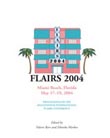Published:
May 2004
Proceedings:
Proceedings of the Seventeenth International Florida Artificial Intelligence Research Society Conference (FLAIRS 2004)
Volume
Issue:
Proceedings of the Seventeenth International Florida Artificial Intelligence Research Society Conference (FLAIRS 2004)
Track:
All Papers
Downloads:
Abstract:
Theissue of fire propagation in cities is of obvious importance to Civil Authorities, but does present issues of computational complexity. Our basic assumption is that some event has occurred to disrupt the normal damage prevention infrastructure, i.e. the Fire Department, so that the fire spreads unhindered through the city. For the most part, the spread of fire is stopped inside the building by construction methods (fire glazing, fire proof treatment of woods etc), and the internal sprinkler systems. In many cities the sprinkler systems are fed by the municipal water supply, so should that fail due to catastrophic damage, buildings will burn uncontrolled. The Fire Control Services are, of course, the next line of defense, but, given our assumption, they are incapable of dealing with the fire for some reason. We then wish to find out how fire will spread in a disaster situation, allowing the fire department and other civil authorities to combat a scenario, armed with the knowledge of what places are most prone to fire spread. To do this we wish to have some representation of cities such that we can measure the likelihood of fire spreading from one building to the next. Therefore we must cover the physics of fire, and then deduce a representation that facilitates the calculation of the fire spread. However, fire, by its nature, is difficult to simulate accurately. As consulted experts agreed that fire spread is a noisy value, due to a huge variety of factors changing the shape of the fire within a building (e.g., the distribution of fuel, heating duct, the shape of the internal structure), applying high accuracy operations to the problem is meaningless. To do this we wish to have some representation of cities such that we can measure the likelihood of fire spreading from one building to the next. Therefore we must cover the physics 1of fire, and then deduce a representation that facilitates the calculation of the fire spread

FLAIRS
Proceedings of the Seventeenth International Florida Artificial Intelligence Research Society Conference (FLAIRS 2004)
ISBN 978-1-57735-201-3
Published by The AAAI Press, Menlo Park, California.
